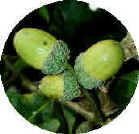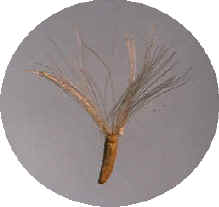1.
Flowering plants grow from seeds. Seeds contain a tiny embryo plant, together with stored
food reserves. The seed is surrounded by a tough coat which protects it. In Britain, seeds
vary in size from the size of a grain of salt (Heather, Foxglove) to a large marble (Horse
Chestnut). The bigger the seed, the more food reserves it contains. |
 |
2. Different kinds of plants produce different
kinds of seeds. The seeds are often carried to new places away from the parent plant. Some
may be blown by the wind, others may be carried by water and others by birds or
other animals. |
. |
| 6. (Above) Pollen grains from
the anthers must get onto the stigma of (usually) another flower. When the pollen lands on
a stigma of a flower of the same kind, it will grow a tube down into the ovary and fertilise an ovule inside. This will then grow and
form a seed. |
|
 |
7.
From little acorns, mighty oaks grow! An Oak tree may live for up to 1000 years. Once it
is mature, it may produce hundreds of acorns every autumn. It needs only one of them to
survive to replace the parent tree when it eventually dies.
. |
|
 |
| 3. When a seed arrives in a suitable habitat, it may immediately start to
grow (germinate). Some seeds however, need to remain dormant for some time before they
will germinate. |

|

|
| 5.
Once plants are adult, they can begin to produce flowers. Flowers contain male and
female parts. In most plants, these are both together in the same flowers. |

|
4. The first two
leaves of a seedling often look different to the adult leaves. They are green and as soon
as they open in the light, the little seedling can begin to make its own food. It then no
longer needs to use the food reserves in the seed. The seedling makes its own food using
water, carbon dioxide from air and light, in a process known as photosynthesis. |